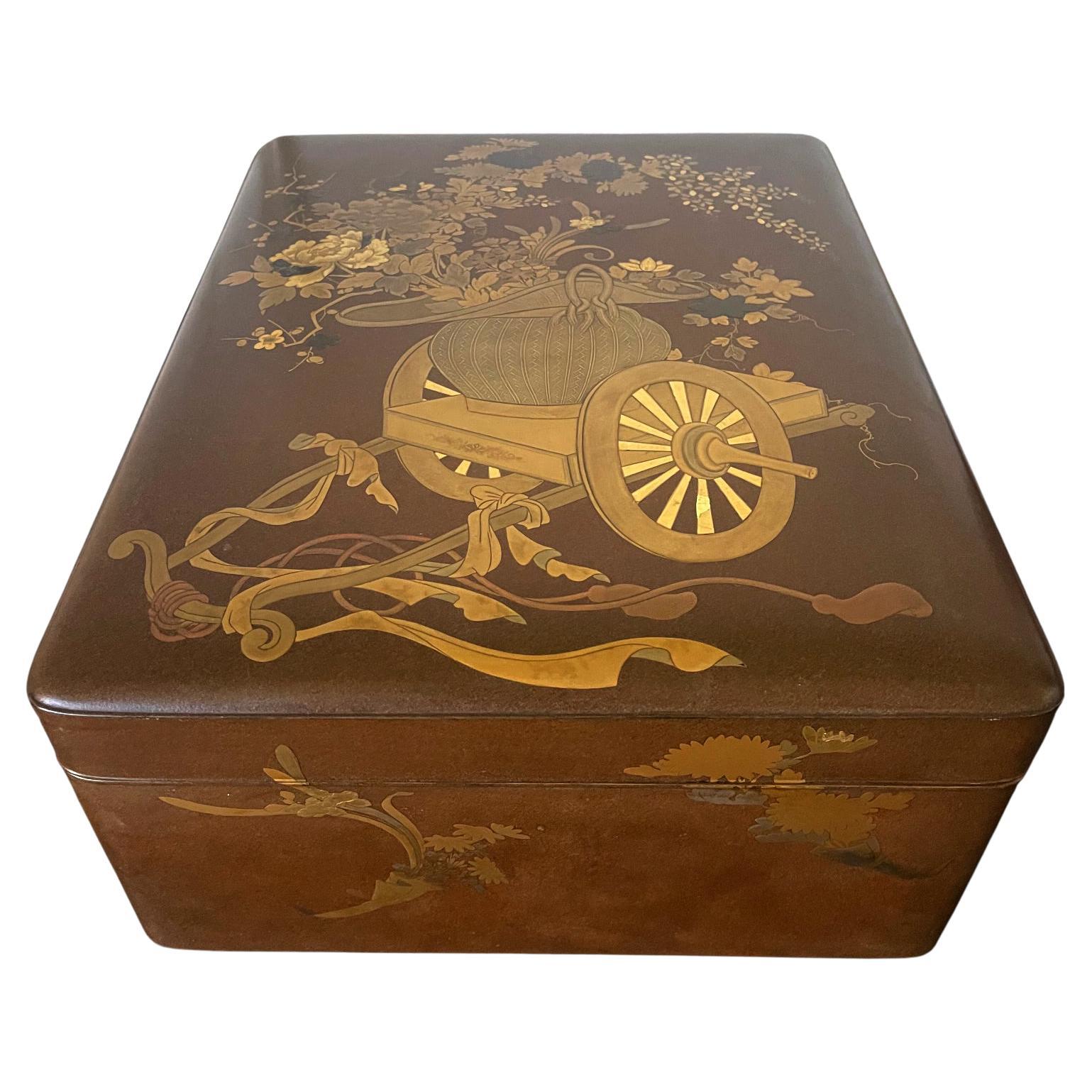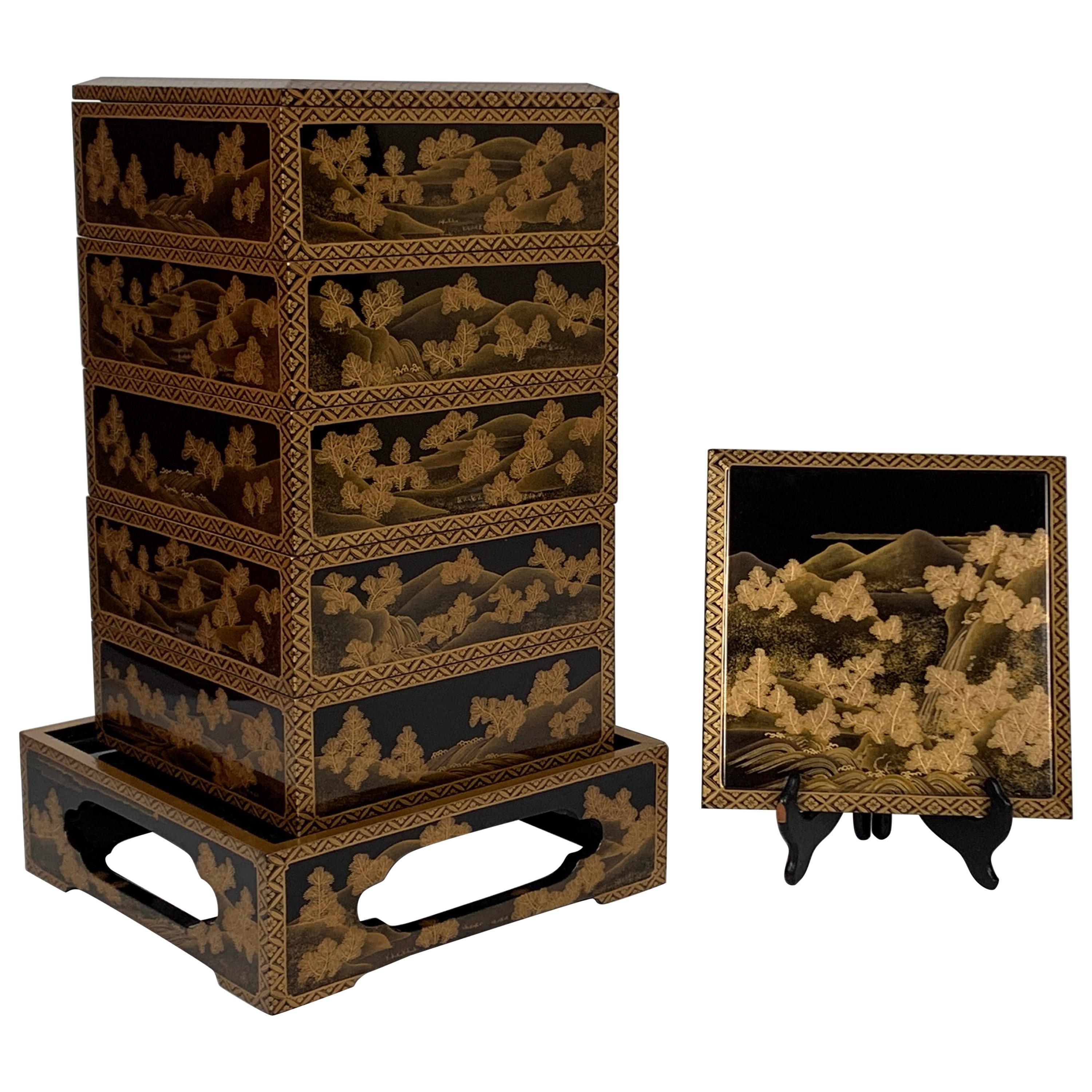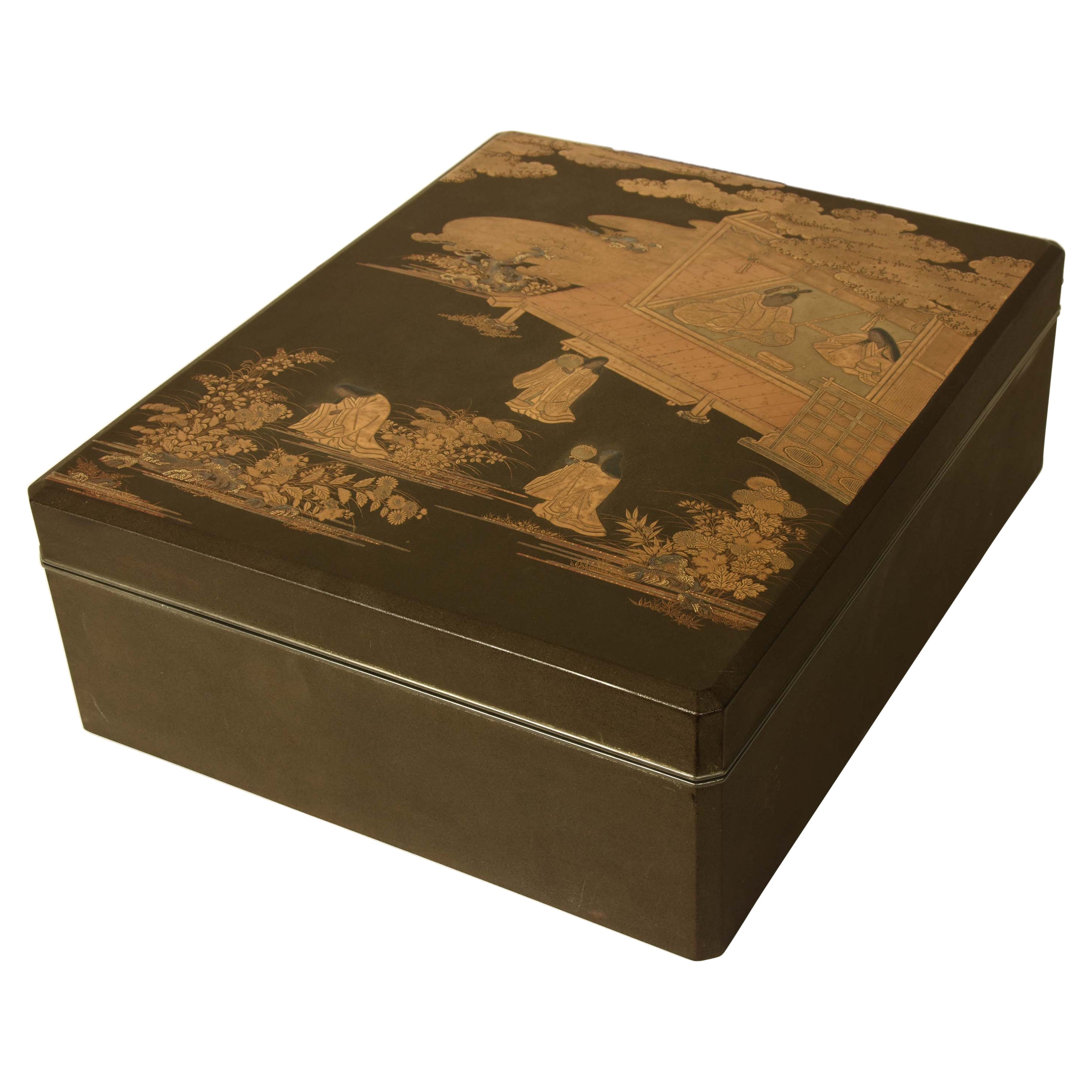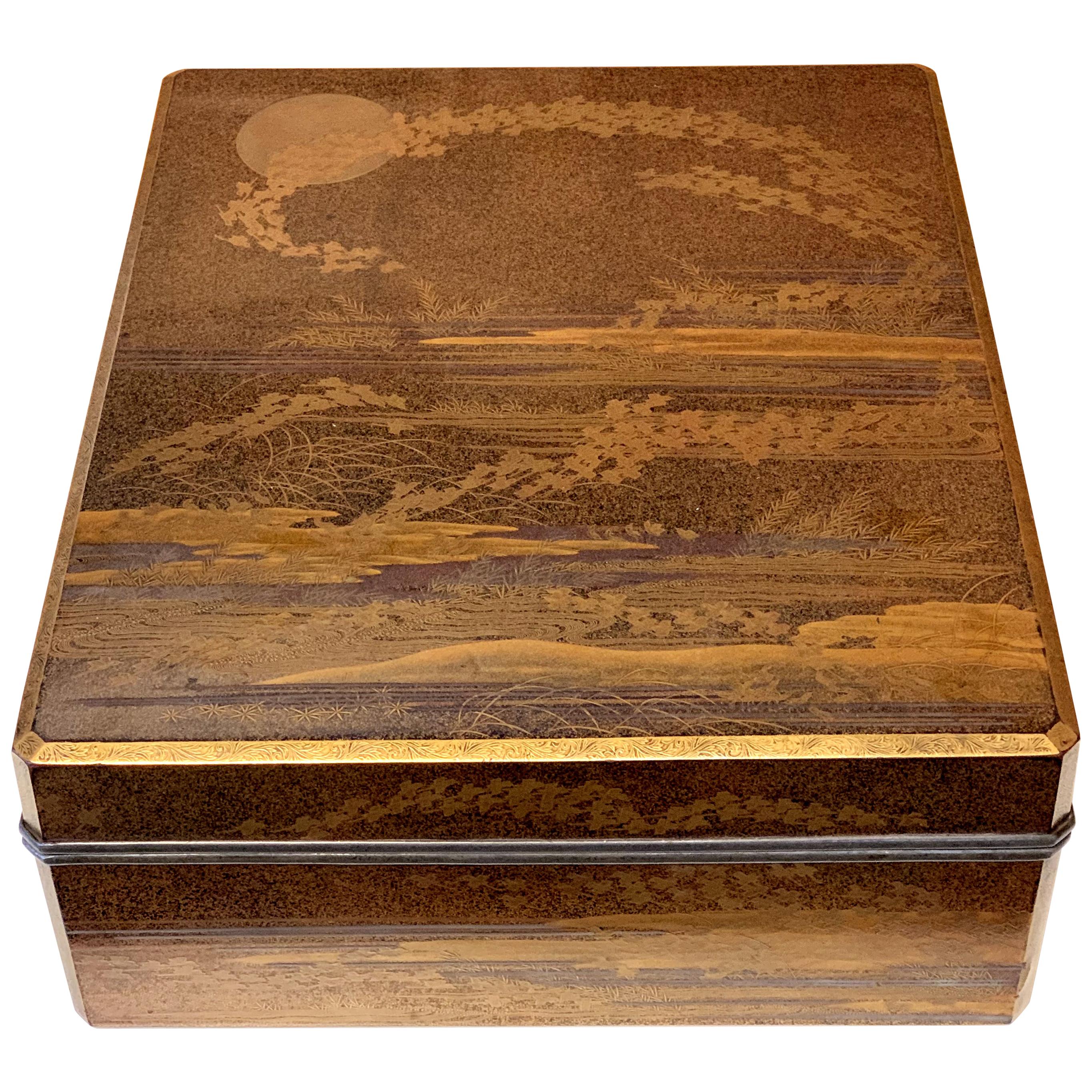Items Similar to Large Japanese Lacquer Document Box, Ryoshibako, Edo/Meiji period, Japan
Want more images or videos?
Request additional images or videos from the seller
1 of 21
Large Japanese Lacquer Document Box, Ryoshibako, Edo/Meiji period, Japan
About the Item
A large and magnificently decorated Japanese lacquer document box, ryoshibako, signed Umeboshi/Baikyo, late Edo or early Meiji Period, mid 19th century, Japan.
The large document box, ryoshibako, of tall, rectangular shape with rounded corners, and fitted with an inrobuta (flush-fitting) cover with beveled edges. The exterior of this exquisite box is decorated all over with fifteen different raised reserves shaped as uchiwa (paddle) fans against a lush and intricate krikane ground imitating shagreen.
The uchiwa shaped reserves all of takamaki-e, and exquisitely painted with designs of animals, flowers, and landscapes in silver, gold, maki-e, hiramaki-e, and takamaki-e, with kirikane, nashiji, and polychrome embellishments, upon gold lacquer fudame grounds.
The interior of the lid is nothing short of spectacular, featuring a large design of a magnificent and beautifully detailed rooster and hen with chicks gathered around a lazy stream. Large stalks of chrysanthemum bloom behind them. All against an ethereal nashiji ground.
The cover of the box features five reserves:
1. Three minogame (turtles with long tails), symbolizing longevity
2. "Narihira Crossing the Sumida" from The Tales of Ise
3. An onagadori (long tailed rooster) and hen with bamboo
4. Togetsukyo bridge
5. Ming Dynasty style blossoming peony and rocks
The sides of the box features ten reserves:
1. Hawk and pine, symbolizing strength and longevity
2. Crucian carp and river prawn
3. Java sparrow and plum
4. Landscape featuring a lazy stream and dragonflies
5. Butterflies and moths, symbolizing rebirth
6. Landscape of a lazy stream by farmhouse
7. Bamboo blind (sudare) with pear branches and blossoms
8. Landscape with plovers (chidori) flying among crashing waves
9. Landscape with pine and cranes, symbols of longevity
10. Long tailed bird and plum
The difference in style, detail, and composition of these fans indicate they are possibly copies of famous paintings or woodblock prints by various artists.
Signed in gold lacquer Umeboshi or Baikyo, with red kaou seal.
The interior of the box decorated with a rich nashiji lacquer ground. The underside of the box of a more subdued nashiji lacquer ground.
- Dimensions:Height: 5.75 in (14.61 cm)Width: 10 in (25.4 cm)Depth: 13.25 in (33.66 cm)
- Style:Meiji (Of the Period)
- Materials and Techniques:
- Place of Origin:
- Period:
- Date of Manufacture:circa 1860
- Condition:Wear consistent with age and use. Minor losses. Minor fading. In very good condition for age. With some minor surface scratches to the lacquer. Minor wear and loss to the kirikane. Wear to the gold lacquered rims. No damage or repairs noted.
- Seller Location:Austin, TX
- Reference Number:1stDibs: LU894735109762
About the Seller
5.0
Gold Seller
These expertly vetted sellers are highly rated and consistently exceed customer expectations.
Established in 2001
1stDibs seller since 2010
305 sales on 1stDibs
Typical response time: 1 hour
- ShippingRetrieving quote...Ships From: Austin, TX
- Return PolicyA return for this item may be initiated within 7 days of delivery.
More From This SellerView All
- Large Vintage Japanese Lacquer Document Box, Ryoshibako, Showa Period, JapanLocated in Austin, TXA large and boldly decorated Japanese lacquer document box, ryoshibako, Showa Period, circa 1960, Japan. The large rectangular box for s...Category
Vintage 1960s Showa Lacquer
MaterialsLacquer
- Japanese Maki-e Lacquer Document Box, Edo Period, early 19th Century, JapanLocated in Austin, TXA spectacular Japanese maki-e lacquer lidded box, possibly a writing box, suzuribako, decorated with images of folding fans, ogi, Edo Period, earl...Category
Antique Early 19th Century Japanese Edo Lacquer
MaterialsCoral
- Japanese Maki-e Lacquer Stacking Box, Jubako, Meiji Period, JapanLocated in Austin, TXA fine and impressive Japanese gold maki-e decorated black lacquer five-tier jubako with presentation tray, two lids, and the original tomobako storage box, Meiji period, late 19th c...Category
Antique Late 19th Century Japanese Meiji Lacquer
MaterialsLacquer
- Japanese Lacquer House Shaped Incense Box, Kogo, Meiji Period, JapanLocated in Austin, TXA delightful and intricately decorated lacquer box for storing incense, kogo, in the form of a traditional farm house, Meiji period (1864 - 1912), late 19th century, Japan. The kogo, or small box for storing incense, takes the whimsical form of a traditional Japanese home, minka, with the removable high, thatched roof serving as the cover for the box. The exterior of the home has been painstakingly decorated in maki-e lacquer against a matte black lacquer ground. Traditional shoji doors, bamboo blinds...Category
Antique Late 19th Century Japanese Meiji Lacquer
MaterialsLacquer
- Japanese Lacquer Stationery Box, Suzuribako, Edo Period, 19th c, JapanLocated in Austin, TXA fine and elegant Japanese lacquer box for writing implements or stationery, suzuribako, with an image of a Shinto shrine, Edo Period, mid-19th century, circa 1840, Japan. The exqu...Category
Antique Mid-19th Century Japanese Edo Lacquer
MaterialsGold Leaf
- Japanese Lacquer Writing Box, Suzuribako, Edo Period, 18th Century, JapanLocated in Austin, TXAn exceptionally fine and unusual Japanese lacquer writing implements box, suzuribako, in the form of a zither, koto, Edo Period, 18th century, Japan. With a modern wood storage box,...Category
Antique 18th Century Japanese Edo Lacquer
MaterialsGold, Silver, Copper
You May Also Like
- Japanese Lacquer Ryoshibako Document Box Meiji PeriodLocated in Atlanta, GAA large Japanese lacquer box with elaborate Maki-e design from Meiji period, (mid-late 19th century). The generous size of the box was reser...Category
Antique 19th Century Japanese Japonisme Lacquer
MaterialsWood, Lacquer
- Japanese Black Lacquer Document Box with Gold Maki e Design, Meiji PeriodLocated in Prahran, VictoriaAn antique black lacquer document box with an exquisitely detailed, finely wrought design from The Tale of the Genji depicted in gold maki e across the lid. Internally, the box is de...Category
Early 20th Century Japanese Lacquer
MaterialsWood, Lacquer
- Large Japanese Lacquer Box Early Edo Period Ex-Christie'sLocated in Atlanta, GAA large lacquer Ryoshibako (Paper box in Japanese) finely decorated with Maki-e circa 17th century early Edo period. The box is of an impressive size and was used to store paper documents. Both sides of the lid were elaborately decorated with maki-e and the edge was befitted with lead rim, an early practice before the silver rim became common later. The interior and base were finished in Nashiji. The night scene on top surface of the lid depicts flocks of chidoris flying in formation from a sea shore swaying with reeds under a full moon, using hiramaki-e in both gold and silver. Ribbons of clouds were achieved with different densities of gold powder. The underside, in contrast, shows a crescent moon in takamakie-e above the sea with ferns and reeds. Chidoris, the plovers, are symbolic in Japanese culture as "thousands of blessings" and longevity. The Namichidori, the pattern in which the chidori flies in the nami (wave) represents the eternal love and safety of couples and families. For detailed references on the historical background and the use of chidoris on lacquerware, see the reference below. This very lacquer box was featured for sale as lot 339 in Christie's London Sale Japanese Art...Category
Antique 17th Century Japanese Japonisme Lacquer
MaterialsWood, Lacquer
- Japanese Rinpa Style Lacquer Box Meiji PeriodLocated in Atlanta, GAA black lacquer tebako (hand box) with maki-e decoration and silver trim, circa late 19th century, Meiji period. The surface of the lid features a Rinpa style maki-e paint depicting ...Category
Antique 1890s Japanese Japonisme Lacquer
MaterialsWood, Lacquer
- Japanese Antique Ewer Lacquer with Bronze Edo to Meiji PeriodLocated in Atlanta, GAA Japanese lacquer water ewer without handle (known as hazo in Japanese) that was used to carry water, traditionally together with a large basin (known as tsunodarai) for domestic us...Category
Antique 19th Century Japanese Japonisme Lacquer
MaterialsBronze
- Small Lacquered Japanese Kazaridana Cabinet, Edo PeriodLocated in Saverne, Grand EstPrecious and rare small kazaridana lacquered on all sides with two drawers and three panels decorated with fish, landscapes and birds. The removable panel reveals a locker with a sma...Category
Antique Late 19th Century Japanese Meiji Lacquer
MaterialsWood
Recently Viewed
View AllMore Ways To Browse
Lazy Bird
Japanese Asian Birds
Japanese Silver Hawk
Tall Antique Japanese Painting
Large Lacquer Boxes
Japanese Red Lacquer Furniture
Japanese Antique Red Lacquer
Silver Rooster And Hens
Antique Bird Prints Red Hawk
Urushi Tray
Cockerel Seal
Black Lacquerware
Red Shibayama
Vintage Wooden Paper Tray
Japanese Tanzaku
Laque Japon
Nara Chest
Negoro Tray





